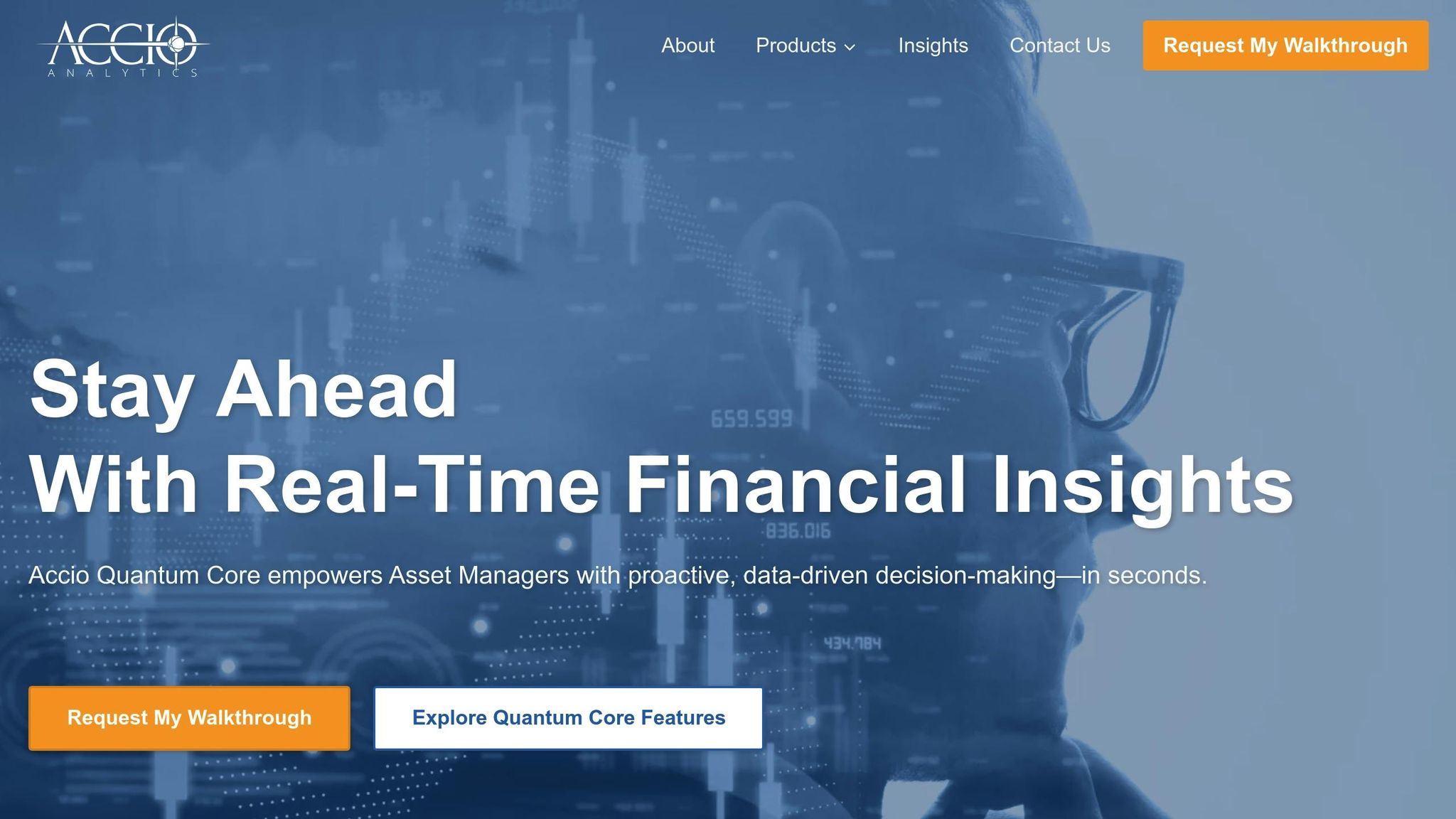How to Use Dashboards for Real-Time Market Insights
Accio Analytics Inc.
11 min read
Real-time dashboards have transformed how investment professionals track and react to market data. These tools provide continuously updated insights, allowing for faster decisions and improved portfolio management. Unlike static reports, real-time dashboards integrate live data from multiple sources and offer features like alerts, interactive visuals, and scenario analysis.
Key Takeaways:
- Live Data Integration: Access up-to-the-second stock prices, trading volumes, and economic indicators.
- Customizable Metrics: Set alerts and track personalized performance indicators for quicker responses.
- Interactive Visualizations: Use dynamic charts and AI-driven tools to analyze trends and predict outcomes.
- Scenario Modeling: Simulate market conditions to stress-test strategies and optimize decisions.
- Accio Quantum Core: A modular platform that integrates seamlessly into existing workflows, providing live updates and advanced analytics.
Real-time dashboards are essential for staying ahead in fast-moving markets. By combining live data, customizable features, and advanced analytics, they enable smarter, faster decision-making.
Key Features of Effective Market Dashboards
Effective market dashboards are designed to turn raw data into meaningful insights. The best platforms incorporate three essential features that empower users to make informed decisions.
Live Market Data Integration
Access to live market data is critical for staying ahead. Dashboards that integrate real-time stock data ensure users have up-to-the-minute information at their fingertips [2]. By connecting to multiple sources – such as major stock exchanges and economic data providers – through reliable real-time data APIs, users gain access to accurate and timely insights [3][4].
"Real-time market data feeds offer continuous access to critical information about stock prices, trading volumes, and economic indicators. These live streams empower investors and traders to react swiftly, gain a competitive edge, and make data-driven decisions with precision." – Daloopa.com [5]
Modern platforms also utilize financial analytics to merge data from various sources, helping analysts uncover trends that can optimize costs and enhance profitability [3].
Customizable Performance Metrics
Dashboards that allow users to track personalized metrics provide a significant edge. Investment professionals can monitor key indicators like revenue, profit margins, portfolio performance, and budget variance. Features such as threshold settings and alerts ensure users are notified when specific conditions are met, enabling quick reactions to market changes [4].
Customization doesn’t just stop at tracking numbers. These tools transform static data into actionable insights through interactive visuals, making it easier to identify patterns and opportunities.
Interactive Visualization Tools
Interactive visual tools simplify complex financial data, making it easier to spot trends and make decisions. Dashboards with features like drill-down analysis, filtering, and real-time updates allow users to explore data dynamically [6].
Advanced tools take this a step further by offering predictive insights, real-time processing, and customizable graphics [7]. These advanced tools can significantly improve efficiency, cutting reporting time by 50% and reducing errors by 69% [7]. For instance, interactive charts combined with AI-driven insights streamline reporting and enhance decision-making [6][7][8].
The best visualization platforms also provide mobile functionality, enabling professionals to monitor markets and make decisions on the go. Look for platforms that include predictive analytics and scenario analysis to anticipate market shifts and assess risks effectively [8]. Additionally, prioritize tools with robust security features, like encryption and access controls, to protect sensitive financial information [7].
How to Build and Use Dashboards for Market Data
Creating a market data dashboard that provides meaningful insights involves a structured approach. The goal is to turn raw financial data into valuable, actionable information. Below are three essential steps to ensure your dashboard delivers real-time insights for smarter investment decisions.
Step 1: Data Integration and Setup
Start by laying a strong data foundation. Secure API access from reliable market data providers like Alpha Vantage, IEX Cloud, or Yahoo Finance. These providers will give you a unique API key for authentication and live market data feeds. Next, configure your system to make RESTful API calls to pull critical market data – such as stock prices, trading volumes, indices, and economic indicators. Once you’ve retrieved the data, use tools like Python or JavaScript to process JSON or XML responses, formatting the information for display.
To make your data visually engaging, choose charting libraries like Chart.js, D3.js, or Highcharts. These tools will help you create interactive visuals. Additionally, ensure your setup supports both push and pull technologies for continuous updates. Once the data is integrated and structured, focus on real-time monitoring by setting up alerts to stay ahead of market changes.
Step 2: Real-Time Monitoring and Alerts
Set up alerts based on thresholds for key metrics like price changes, volume surges, or spikes in volatility. When these thresholds are crossed, trigger notifications through email, SMS, or in-dashboard alerts. To keep your data current, enable real-time refreshes using WebSocket connections or frequent API calls (e.g., every 5 seconds).
Design these alerts to be role-specific so that each team member receives only the information relevant to their responsibilities. Research shows that companies using interactive dashboards are 28% more likely to detect timely insights compared to those relying on static reports [9]. With your alert system in place, you can also use the dashboard to simulate market scenarios, helping you refine strategies and make informed decisions.
Step 3: Scenario Analysis and Optimization
Take your dashboard to the next level by incorporating scenario modeling. Add features to simulate base, best-case, and worst-case scenarios to stress test market conditions and optimize outcomes [11]. For example, a SaaS company used scenario analysis to project revenue under different conditions: a base case with 5% churn and 10% new growth led to a 12% ARR growth, while a best-case scenario with 3% churn resulted in 20% ARR growth.
Interactive filters can help you dive deeper into specific time periods, asset classes, or market segments, tailoring insights for more precise decision-making. Use dynamic stress testing to assess how various scenarios might impact revenue, cash flow, or profit margins. Keep your scenarios up to date by revisiting them after significant market events. Lastly, gather user feedback regularly to improve the dashboard’s functionality, ensuring it continues to deliver relevant and actionable insights over time. This ongoing refinement will maximize its strategic value and keep it aligned with evolving business needs [10].
sbb-itb-a3bba55
Using Accio Quantum Core for Advanced Market Analysis

Accio Quantum Core takes interactive dashboards to the next level, transforming them into real-time analytics tools that integrate smoothly with your current operations. This platform isn’t just about providing data – it’s about delivering actionable insights when you need them most.
Integration with Existing Workflows
One of the biggest hurdles for financial firms is dealing with outdated systems that generate data but lack flexibility. Accio Quantum Core solves this issue with its API-based design, allowing it to connect directly to your existing infrastructure without forcing a full system overhaul.
The platform’s modular structure lets you enhance specific areas of your workflow without disrupting everything else. For instance, you can deploy risk agents to enhance basic portfolio tracking, adding functionality precisely where it’s needed. This targeted approach preserves your investment in existing systems while layering in advanced capabilities.
Unlike traditional system replacements, which can take anywhere from 9 to 18 months, implementing Accio Quantum Core typically takes just 2-3 weeks [12].
"Accio Quantum Core transforms how investment teams interact with performance data – delivering real-time, dynamic insights exactly when you need them."
– Accio Analytics [12]
The platform also integrates effortlessly into your team’s daily routines. Portfolio managers can stick with their familiar interfaces while gaining access to live data streams and advanced analytics. Instead of requiring a complete shift in processes, the system works alongside your current strategies, enhancing them for better results.
Live Metrics and Dynamic Adjustments
With workflows integrated, Accio Quantum Core’s live metrics enable real-time strategy adjustments. Unlike traditional dashboards that update periodically, this platform delivers real-time insights in seconds [12].
Dynamic adjustment features let investment teams tweak parameters and thresholds instantly. For example, if market volatility spikes during trading hours, you can quickly adjust risk monitoring thresholds without needing IT intervention. The Holdings Agent ensures position calculations reflect these updates immediately, while the Returns Agent provides live performance attribution as conditions change.
This capability becomes especially crucial during market stress events. When sudden news or volatility hits, the dashboard updates risk exposures and performance metrics in real-time, allowing for immediate strategic decisions.
Whether you’re monitoring standard deviation, sector exposures, or performance attribution, Accio Quantum Core ensures you receive actionable insights as markets evolve.
Modular Tools for Scalability
Accio Quantum Core’s microservices architecture offers unmatched flexibility, enabling your firm to scale its analytics capabilities as needed. Each agent operates independently, forming a system that can grow with your firm’s requirements.
Here’s a closer look at some of the platform’s agents:
- Transactions Agent: Manages real-time positions, eliminating delays caused by overnight batch processing.
- Risk Ex-ante Agent: Provides forward-looking risk analysis, seamlessly integrating with historical performance data.
- Storyboards Agent: Creates dynamic, executive-ready visualizations that update automatically as data changes.
Each agent is designed with built-in validation and trace functionality, ensuring data accuracy and providing complete audit trails for regulatory compliance. This means you get the speed and flexibility of modern analytics without compromising on reliability or institutional standards.
The modular design also helps optimize costs. Instead of investing in an entirely new platform, you can deploy only the agents you need right now and expand capabilities as your analytical needs grow. This approach makes it easier to adapt to changing demands while keeping expenses under control.
Best Practices for Implementing Real-Time Dashboards
Avoiding Information Overload and Alert Fatigue
When it comes to real-time monitoring, managing alerts effectively is key to avoiding burnout and maintaining decision-making quality.
"Alert fatigue is a state of mental and operational exhaustion caused by an overwhelming number of alerts – many of which are low priority, false positives or otherwise non-actionable."
Studies reveal that 62% of employees have linked alert fatigue to turnover, while 60% report it has caused internal conflicts within their organizations [13]. Security Operations Center (SOC) teams, in particular, spend a staggering 32% of their workday dealing with false alerts [13].
To combat these challenges, start by setting conservative thresholds based on historical trends. If alerts are being triggered for minor changes – like a 5% fluctuation when action is only warranted at 15% – adjust thresholds accordingly. Fine-tuning these limits lays the groundwork for smarter alert consolidation and prioritization.
Here’s how to streamline alerts:
- Consolidate notifications: Instead of bombarding users with separate alerts for related events (e.g., multiple stocks in the same sector dropping), group them into a single, context-rich notification.
- Prioritize importance: Ensure that critical alerts bypass standard channels, while less urgent ones are batched and delivered together.
- Automate responses: For recurring conditions, automate routine actions to lighten the manual workload.
- Audit regularly: Review alert patterns periodically and eliminate those that never lead to action.
Conclusion and Key Takeaways
Real-time dashboards are changing the game when it comes to market analysis and decision-making. Companies leveraging real-time analytics report a 22% faster response to market events and a 17% improvement in decision-making accuracy[1].
The foundation of a successful dashboard lies in three key components: data integration, real-time monitoring with alerts, and scenario analysis. Together, these elements create a system that transforms raw market data into actionable insights. The real challenge is maintaining a balance – using immediate insights effectively while keeping an eye on historical trends to guide long-term strategies.
By incorporating cutting-edge features, Accio Quantum Core addresses the limitations of traditional dashboards. Its API-driven design fits seamlessly into existing workflows, avoiding disruptive changes. Specialized agents manage tasks like live holdings calculations and predictive risk analysis. The platform’s ability to dynamically track metrics such as standard deviation in real time and adjust thresholds is a big step forward compared to older batch processing systems.
In volatile markets, these dashboards provide instant alerts, enabling portfolio managers to react quickly. Unlike static reports, which might take hours or even days to show updates, real-time systems empower teams to protect capital and act decisively.
Advancements in AI and machine learning take dashboards beyond just reporting – they now offer predictive analytics and automated recommendations. Investment professionals who adopt these tools gain a sharper edge, making it easier to navigate complex market conditions with confidence.
To get the most out of a dashboard, focus on data accuracy, intuitive design, and well-configured alerts. Even the most advanced systems can fall short if they’re not optimized properly. The ultimate goal is to deliver the right information to the right people at the right time, turning overwhelming amounts of data into a clear strategic advantage.
FAQs
How do real-time dashboards help investment professionals make better decisions compared to static reports?
Real-time dashboards give investment professionals a powerful edge by offering instant insights into market trends. Unlike static reports that can quickly lose relevance, these dashboards deliver continuous updates on key metrics such as asset performance, volatility, and portfolio health.
This real-time access means professionals can react immediately to market changes, fine-tune strategies as needed, and capitalize on new opportunities as they arise. By eliminating delays and presenting actionable data on the spot, these tools help reduce risks and simplify decision-making, ensuring you stay ahead in the ever-changing financial world.
What should I look for in a real-time market dashboard to gain actionable insights?
A top-notch real-time market dashboard should deliver live data updates, customizable metrics, and interactive visualizations to help you keep a close eye on market trends. Tools that include predictive analytics can be especially valuable, enabling you to anticipate shifts before they happen. Plus, the ability to set thresholds and receive instant alerts for major changes ensures you’re always in the loop.
These capabilities give investment professionals the edge they need to make quick, well-informed decisions in a constantly evolving market. The most effective dashboards blend seamlessly into your workflow, complementing your strategies without forcing you to overhaul your processes.
How does Accio Quantum Core enhance existing financial systems without requiring a full replacement?
Accio Quantum Core connects effortlessly with your current financial systems through API connections, so there’s no need to replace your existing setup. Instead, it upgrades your infrastructure by adding advanced features like real-time insights, multi-chain functionality, and automation.
Designed to align with your workflows, Accio Quantum Core equips you with powerful tools to refine your strategies while keeping your operations running smoothly. It’s a seamless way to transition into cutting-edge capabilities without any unnecessary disruptions.




